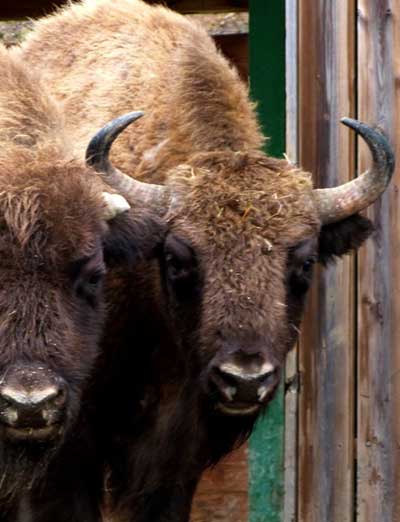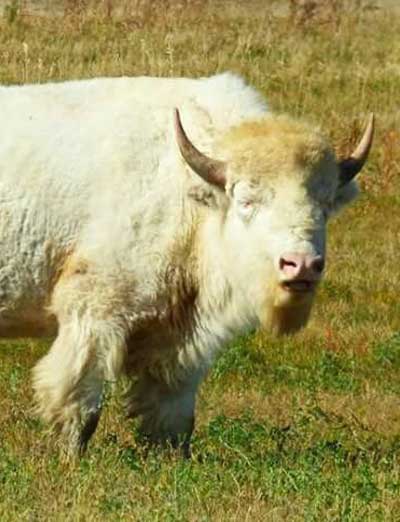Understanding
Bison-Cattle Introgression
Genetics is a complex and complicated subject even for most geneticists. The simple genetics we all learned in high school or college biology just touches upon easy to understand genetic elements. Trying to simplify complex genetic interactions often results in misinterpretations and misconceptions. We attempt here to explain things in simple terms with minimal error or misinterpretations.
Simply put, introgression is the movement of genes (DNA) from one species into the gene pool of another species by the repeated backcrossing of a hybrid with one of its parent species [1]. Introgression is not the same as simple crosses, such as the mule or hinny. Rather, introgression is a long-term process which often involves many hybrid generations before the backcrossing occurs. An example of introgression would be the modern-day Beefalo which is 3/8 (37.5%) bison [2]. Depending on the amount of generational backcrossing, animals may be almost indistinguishable from the initial species. Once introgression occurs, regardless of the amount of backcrossing and generations, traces of that introgression will always be present. It is not a reversible process.
Introgression or hybridization between species is a natural part of the evolutionary process and all modern-day life forms, from plants to mammals, have undergone introgression at some point in their evolution. The "Higgs" bison, allegedly the result of cross breeding (hybridization) between the ancestor of cattle (the extinct Auroch) and the Steppe Bison some 120,000 years ago [3, 4] is an example of ancient introgression in the evolution of modern-day bison.
Another example is the introgressive hybridization or admixture between humans (Homo sapiens), Neanderthals (Homo neanderthalensis), and Denisovans (Homo denisova) that occurred some 100,000 and 40,000 years ago, both before and after the out-of-Africa migration some 70,000 years ago [5, 6]. As a result, Neanderthal-derived DNA can be found in the genome of contemporary populations in Europe and Asia, accounting for between 1% and 6% of modern human DNA. The highest rates of admixture overall have been found in indigenous Oceanian and Southeast Asian populations, with an estimated 4–6% of the genome of modern humans being derived from Denisovans [7].
Although there is nuclear Neanderthal DNA in modern humans, Neanderthal mitochondrial DNA has never been found in modern humans [8] (mitochondrial DNA is only passed to offspring by the mother). This suggests that successful mating with Neanderthals happened only between male Neanderthals and human females rather than with maternal Neanderthals. This is similar to bison-cattle breeding where the cattle bull and bison female do not mate. This will have implications later when we discuss how introgression is detected.
It is well documented that most of the ranchers that saved the bison (including the 5 so called "foundation herds") were primarily cattle ranchers that experimented with creating cattalo. This is a historical and scientific fact [9-12]. The cattalo (similar but not exactly same as the Beefalo) is a bison-cattle hybrid created in the late 1800's and early 1900's by crossing a male bison with a bovine female. This first generation cross (F1) of the bison bull and bovine female produces predominately females as the males, if born at all, are sterile.
The purpose and reason for crossing bison and cattle was an effort to incorporate favorable agricultural traits from bison into cattle, including meat quality and quantity, hardiness, feed efficiency, and disease resistance [10, 13]. Bison bulls were crossed with domestic cows because the reciprocal cross, domestic bull and bison cows, would not mate (the beefalo is the reciprocal cross). This cross has low birth rates (Boyd [10] reported abortions in over 50% of bred domestic cows and the few males that were born died within 24 hours). This F1 hybrid cross between the bison bulls and domestic cows produced female offspring that had 50% autosomal (nuclear) cattle ancestry, 100% cattle mtDNA, and 0% cattle Y ancestry. As a result there is an excess of cattle mtDNA ancestry in modern-day bison and a deficiency of cattle Y chromosomal ancestry [10, 14]. Although these first generation F1 females could be backcrossed with bison bulls to produce predominately females and a few sterile males [10], the preferred backcrosses were to domestic bulls so that commercially favorable bison characteristics could be introduced into cattle.
What is generally overlooked is the fact that the bison-cattle crossbreed in the first generation tend to look very much like purebred bison; appearance is completely unreliable as a means of determining what is a purebred bison and what is a crossbred hybrid [9, 12]. Subsequent crosses with bison makes the distinction even more difficult. As noted by Hornaday "no difference whatever observable between this lusty young half-breed and a full blood buffalo calf of the same age and sex" and that these hybrids "so strongly resemble a pure-blood buffalo as to be generally mistaken for one". It is thus not surprising that some of these hybrids may have been mistaken for pure bison.
The idea behind creating the cattalo (or beefalo today) was the hopes of combining the superior hardiness, foraging ability, calving ease, and meat quality of the bison with the fertility, milking ability, and ease of handling of the bovine [9, 12]. When thousands of cattle died during the Kansas blizzard of 1886 [15], and the bison survived without any noticeable loss, bison-cattle hybrid experiments hoped that these hybrids could better survive harsh winters. Charles Goodnight, Michel Pablo and Charles Allard, Charles "Buffalo" Jones, all experimented with cattalo and often traded these animals amongst themselves and others [9, 10, 12].
The great successes made by these early pioneers regarding their cattalo were not entirely truthful [10, 14]. These animals (bison bulls crossed with bovine females) had low fertility resulting in low birth rates. Females that became pregnant, presumably due to the calf size at birth, often resulted in both the calf and cows death. In addition, male calves were either born dead or were sterile; thus only female crosses survived. This F1 generation consisting of only female will have implications in determining bison-cattle introgression. Eventually the bison-cattle crosses and hybrids were discontinued as the problems with the hybrids were revealed.
Nevertheless, although the cattalo experiments were discontinued, all modern day bison were exposed to cattle introgression and the fingerprints of these early experiments are present in many modern-day bison populations.
Surprisingly though, the percent of bison having evidence of cattle introgression is relatively low. While it may be true that most (or many) private and federal herds have evidence of cattle introgression [14, 16, 17], the number of actual individual animals is low, somewhere between 7-10%, maybe even less. Some herds, however, have a much higher prevalence of cattle introgression within their bison herds [18, 19] due in part to inbreeding and ignoring the existence of cattle genes within breeding stock. Unfortunately this can easily happen with the introduction of a single animal with cattle genes into the breeding herd. If that animal happens to be your herd sire and his offspring becomes part of your breeding herd, cattle introgression markers and genes can spread through a herd rather quickly. You can view cattle introgression as a venereal disease, spreading through the herd with each reproductive cycle.
The presence of cattle introgression markers, and hence cattle genes, may be spreading exponentially through the bison industry due to the general disregard of the issue by the industry and breeders alike. It may only be a matter of time before there are only bison hybrids remaining. By definition, a bison with evidence of introgression and the presence of modern-day cattle genes is a hybrid animal.
Next Articles in this Series:
How is introgression detected?
Understanding how introgressions are detected is critical to interpreting the implications of cattle introgressions in bison
About the Author:
R. J. ChiodiniOzark Valley Bison Ranch, LLC
Past Assistant Professor, University of Connecticut, Storrs & Farmington
Past Associate Professor, Brown University, Providence
Past Associate Professor, Texas Tech University Health Sciences Center, El Paso
Past Professor, Montana State University, Billings
Currently Retired
Author's Past Articles
References:
[1] Wikipedia. Introgression. 2018. Available at: https://en.wikipedia.org/wiki/Introgression[2] Wikipedia. Beefalo. 2018. Available at: https://en.wikipedia.org/wiki/Beefalo
[3] Soubrier J, Gower G, Chen K, Richards SM, Llamas B, Mitchell KJ, et al. Early cave art and ancient DNA record the origin of European bison. Nature communications. 2016;7:13158. Available at: http://www.ozarkbisons.com/literature/genetics/soubrier_2016.pdf
[4] Shapiro B, Drummond AJ, Rambaut A, Wilson MC, Matheus PE, Sher AV, et al. Rise and fall of the Beringian steppe bison. Science. 2004;306:1561-5. Available at: http://www.ozarkbisons.com/literature/genetics/shapiro_2004.pdf
[5] Wills C. Genetic and phenotypic consequences of introgression between humans and Neanderthals. Advances in genetics. 2011;76:27-54. Available at: http://www.ozarkbisons.com/literature/genetics/wills_2011.pdf
[6] Huerta-Sanchez E, Jin X, Asan, Bianba Z, Peter BM, Vinckenbosch N, et al. Altitude adaptation in Tibetans caused by introgression of Denisovan-like DNA. Nature. 2014;512:194-7. Available at: http://www.ozarkbisons.com/literature/genetics/huerta-sanchez_2014.pdf
[7] Reich D, Green RE, Kircher M, Krause J, Patterson N, Durand EY, et al. Genetic history of an archaic hominin group from Denisova Cave in Siberia. Nature. 2010;468:1053-60. Available at: http://www.ozarkbisons.com/literature/genetics/reich_2010.pdf
[8] Serre D, Langaney A, Chech M, Teschler-Nicola M, Paunovic M, Mennecier P, et al. No evidence of Neandertal mtDNA contribution to early modern humans. PLoS biology. 2004;2:E57. Available at: http://www.ozarkbisons.com/literature/genetics/serre_2004.pdf
[9] Dafoe JW. Domestication of the Buffalo. Popular Science Monthly 1889;34. Available at: http://www.ozarkbisons.com/literature/genetics/dafoe_1889.pdf
[10] Boyd MM. Crossing bison and cattle: First Cross Dangerous But Results are Better in Each Succeeding Generation—Hope of Taking Fur and Hump of Bison and Placing Them Upon Back of Domestic Ox. J Heredity. 1914;5:189-97. Available at: http://www.ozarkbisons.com/literature/genetics/boyd_1914.pdf
[11] Halbert ND, Gogan PJP, Heibert R, Derr JN. Where the buffalo roam: The role of history and genetics in the conservation of bison on U.S. federal lands. Park Science. 2007;24. Available at: http://www.ozarkbisons.com/literature/genetics/halbert_2007.pdf
[12] Hornaday WT. Extermination of the American Bison. In: Smithsonian Institution USNM, editor. Report of the National Museum: Government Printing Office; 1889. p. 369-548. Available at: http://www.ozarkbisons.com/literature/genetics/hornaday_1889.pdf
[13] Goodnight C. My experience with bison hybrids. J Heredity. 1914;5:197-9. Available at: http://www.ozarkbisons.com/literature/genetics/goodnight_1914.pdf
[14] Hedrick PW. Conservation genetics and North American bison (Bison bison). The Journal of heredity. 2009;100:411-20. Available at: http://www.ozarkbisons.com/literature/genetics/hedrick_2009.pdf
[15] Kansas Historical Society. Blizzard of 1886. 2011. Available at: https://www.kshs.org/kansapedia/blizzard-of-1886/11982
[16] Halbert ND, Derr JN. A comprehensive evaluation of cattle introgression into US federal bison herds. The Journal of heredity. 2007;98:1-12. Available at: http://www.ozarkbisons.com/literature/genetics/halbert_2007-2.pdf
[17] Polziehn RO, Strobeck C, Sheraton J, Beech R. Bovine mtDNA Discovered in North American Bison Populations. Conservation Biology. 1995;9:1638-43. Available at: http://www.ozarkbisons.com/literature/genetics/polziehn_1995.pdf
[18] Halbert ND, Raudsepp T, Chowdhary BP, Derr JN. Conservation genetic analysis of the Texas State Bison Herd. Journal of Mammalogy. 2004;85:924-31. Available at: http://www.ozarkbisons.com/literature/genetics/halbert_2004.pdf
[19] Kiesow AM, Kasmarik T, Binstock RL. Detection of domestic cattle gene introgression in a small population of North American Bison. Proc S Dakota Academy of Sci. 2011;90:75-81. Available at: http://www.ozarkbisons.com/literature/genetics/kiesow_2011.pdf
- Understanding Bison-Cattle Introgression
- Detection of Cattle Introgression in Bison
- Does it really matter that bison have cattle genes?
- Finding and Maintaining Genetically Pure Bison
- My Personal Views and Opinions
The original introgression page can be found HERE

Bison-cattle crosses

- Introgression, admixture, and hybridization are all natural and common evolutionary processes.
- Genes associated with these evolutionary events remain within the DNA for thousands of years and are likely never to be eliminated from the genome.
- Cattle ranchers in the late 1800's and early 1900's, including those credited with saving the bison and considered the foundation herds of modern-day bison, experimented with bison-cattle crosses and hybrids called cattalo.
- These cattle-bison hybrids were often indistinguishable from pure bison.
- Many bison have evidence of cattle introgression with either cattle-type mtDNA or microsatellite markers in their nuclear DNA or both.
- Most federal and private bison herds have animals with evidence of cattle introgression.
- Cattle introgression markers and associated cattle genes can rapidly spread through a herd.
- Only about 10% of bison currently have evidence of cattle introgression, but this is rapidly increasing.
- A bison with evidence of cattle introgression is a hybrid by definition
